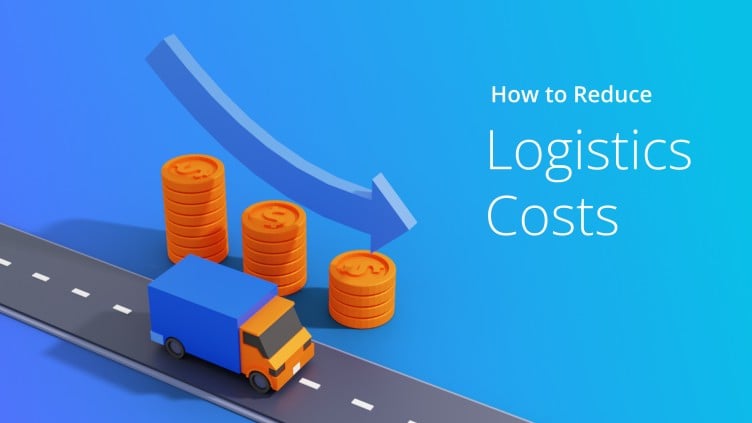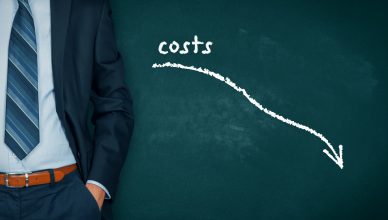According to Statista, global logistics costs amounted to $9.1 trillion in 2020 and are expected to continue rising in 2022. Rising costs can profoundly impact your business, so you must learn how to measure them to reduce expenses and budget accordingly.
To help you improve your bottom line, we’ve shared information on the types of costs you can expect as a logistics company. Additionally, we’ve provided tips for logistic cost reduction without affecting the quality of your services.
Table of Contents
Types of Logistics Costs
Whether you have a start-up logistics company or a more complex organization, there are 4 logistics costs you need to be aware of. Knowing the types of expenses will help you think of ways to reduce logistics costs.
Inventory Management Costs
Inventory costs are expenses associated with managing the stock in your company. It’s a common contributing factor to high costs for logistics. These inventory costs include:
– Ordering costs: Expenses incurred by procuring inventory which include the cost of purchase and inbound logistics.
– Holding costs: Expenses incurred by inventory shortage and infrastructure maintenance. Cost is dependent on whether your business manages in-house inventory or outsourced vendors.
– Shortage costs: These expenses happen when you have no inventory in stock, including the loss of business and margin on sales.
Managing your stocks versus customer demand can impact your bottom line. If you stock too many units, it can affect cash flow. However, you could lose out on business if you don’t have enough stock.
If you don’t manage your inventory costs, you could experience:
– Customer loss
– Wasted inventory
– Shipping delays
– Poor forecasting
– Lower rates on inventory turnover
– Volatile overhead costs
Warehousing Costs
Another major factor that can cause high logistics costs is warehousing. You’ll need a facility to store your inventory and a bigger space to hold the stock if you have a large organization. Costs will depend on whether you’ve built a warehouse or rented out an area on your premises.
According to a report from Wall Street Journal, inflation caused a 25% increase in warehouse lease renewals in 2021. However, having your own warehouse isn’t always cheaper because you have to factor in:
– Insurance costs: You will need liability insurance to cover lost, stolen, or damaged goods and machinery. You could spend as much as $93 per month or $1106 annually on warehouse general liability insurance.
– Security costs: To protect your inventory, you’ll need warehouse security systems which can cost between $5000 and $25000. However, security systems can pay off in loss reduction. Other costs include paying security guards to patrol your grounds.
– Utilities: The cost of electricity can eat into your budget, especially if you’re running physical machines and digital automation systems. Other costs include running forklift trucks in your warehouse.
High warehousing costs result from poor forecasting and unexpected shifts in customer demand. Your organization must find a way to track and manage fluctuations in supply and demand because proper tracking optimizes warehouse costs.
Transportation Costs
Transportation costs have reached an all-time high due to the rising fuel price. The US gas cost recently hit $5 a gallon, the highest it’s ever been. Transportation causes the highest logistics costs whether you have an in-house team or use third-party companies.
These costs include the following:
– Transporting raw materials to a manufacture
– Moving products from the manufacturer to the warehouse
– Delivering goods to customers
With ineffective inventory management, a burden is placed on transportation because you may need to expedite shipping to ensure packages arrive on time. When your company grows, indirect costs associated with inventory inefficiencies can increase logistics costs.
Distribution Costs
Distribution costs are incurred by any activity that involves placing a finished product in your customer’s hands.
These costs include:
– Packing
– Advertising
– Selling
– Shipping
– Administrative expenses
Factors such as throughput times, vehicles, and scheduling can contribute to a high logistic cost. There is high variability in distribution costs, making it difficult to track and manage. You need to do logistics cost analysis to examine all costs associated with distribution.
Want To See For Yourself How Route4Me Can Help Reduce Logistics Costs?

How to Measure Logistics Costs
Your company must measure logistics costs monthly so your monthly expenses don’t exceed your budget. Measuring costs will provide information on your company’s performance to see where you’re making a profit and running at a loss. Here are steps to measure expenses for each type of logistics costs:
– List your line items for each category
– Record the exact cost for each expense
– Add up your line items in each category
By adding up your line items in each logistics category, you can measure each more accurately.
Inventory Costs:
You can determine inventory costs as the cost of short-term storage for products waiting to ship and items in your warehouse you need to sell. Include expenses such as labor, utilities, and space. Divide your inventory costs with your profit.
For example if your inventory costs are $42,000 and profit 120,000 your calculations will be: $42,000/$120,000= 0.35 or 35% inventory costs.
Warehouse Costs:
Calculate your warehouse costs as the expenses for the long-term storage of goods in your warehouse. Here you will include fees for space, utilities, and payroll for warehouse staff. You can either record warehouse costs as cash value or a percentage of your total sales by dividing your warehouse expenses by your total revenue.
For example, if your warehouse costs are $28,500 and revenue 190,000, your calculation will be: $28,500/$190,000= 0.15 or 15% warehouse costs.
Transportation Costs:
Divide the total transportation cost by the total sales of transported goods to find the percentage cost. Include all costs such as insurance, fuel, maintenance, and payroll.
For example, if your total transportation costs are $30,000 and you make a profit of $120,000, you can calculate:
30,000/120,000=0.25 or 25% transportation costs.
Distribution Costs:
Add up all your expenses in the distribution process, which will include advertising, transportation, selling, and administrative costs. You can then divide your total expenses by profits.
For example, if your distribution costs add up to $35,000, then calculate: 35,000/120,000=0.29 or 29% distribution expenses.
How to Reduce Logistics Costs
Now that you know what type of logistics costs, here are 5 tips to help reduce expenses. With proper logistics cost management, you can experience an increase in revenue and find opportunities to expand your business.
Increase Average Order Value
Try to reduce cart abandonment rates and increase average order value.
Cart abandonment often happens due to the high cost of shipping fees. You could offer lower shipping costs or free delivery for orders over a certain amount of money. For example, you can offer free delivery for orders over $500, which increases the average order value.
With a good supply chain, you can beat your competitors on the retail price and boost your profit. Additionally, with a high-performing organization, you’ll meet or exceed your customer’s expectations when delivering items. You’ll then retain existing customers and attract new ones, improving revenue.
Optimize Last-Mile Delivery to Reduce Logistics Costs
Last-mile delivery is the most expensive leg of the supply chain. According to a report, last-mile delivery costs are substantial, comprising 53% of overall shipping expenses. Therefore, optimizing last-mile delivery is critically important to reduce costs.
Use an advanced multi-stop route planner like Route4Me to plan fuel-efficient routes. The software considers weather, traffic, roadblocks, road intersections, and many other constraints that could slow down your drivers and increase fuel costs.
With the delivery scheduling software, you can assign balanced workloads to ensure every driver has enough work and avoid any chances of empty vehicles doing the rounds.
Plus, the Route4Me route planner offers a reporting and analytics feature that helps you track fuel consumption and control the costs.
Route4Me’s vehicle routing software offers a GPS tracking feature that helps you track vehicle movements in real-time and ensures drivers don’t waste fuel by taking longer routes or engaging in reckless driving.
Learn in detail how to reduce last-mile delivery costs.
Keep Delivery In-House
Some companies use third-party organizations for deliveries. However, your company will have to adjust to the third-party’s processes. Their delivery processes and how they treat your customers will be out of your control.
Instead, you can build an in-house delivery team to better control your logistics processes and costs.
It may seem like keeping the delivery department in-house can increase costs as you have to bear many fixed and variable expenses such as salaries, insurance premiums, vehicle purchasing expenses, and fuel and vehicle maintenance costs.
But outsourcing to a third party can cost you more if they charge a hefty commission. Plus, there could be set-up costs, onboarding expenses, and hidden charges that you would only realize after subscribing or purchasing their services.
The best way is to use a route planner for your in-house delivery, so you never need to worry about unnecessary expenses.
Here’s a detailed guide on in-house vs. third-party delivery to help you make the right decision.
Automate Logistics and Warehouse Processes to Reduce Logistics Expenses
Automating your warehouse and logistics processes improves workflow and allows your team to deliver packages faster. With automation, you can reduce human workers in your warehouse, which will save on payroll costs. Although the cost of automation can be high, you’ll save on costs long term.
With automated storage and retrieval systems, your logistics team members can achieve more significant outcomes with fewer resources, time, and effort. You can move stock faster, bringing in more goods to sell and potentially boosting your profits.
Optimize Your Inventory to Decrease Logistics Costs
Effective inventory optimization is one of the best logistics cost-saving initiatives, so you always have products on hand to fulfill customer orders. Your organization should always have safety stock to prepare for unforeseen circumstances such as:
– Damaged products on the shelves
– Delayed shipments from your manufacturers
– When customers order more than one of the same item
Here are inventory optimization techniques:
– Demand forecasting: Use tools and technology that help you understand customer demand will help you make better supply decisions. You can calculate the total sales and revenue for a specific time using insights on sales trends.
– Reorder point formula: You must know optimal times to reorder stock. To calculate reorder points use this formula: Reorder Point (ROP) = Demand during lead time + safety stock.
– Inventory audits: Your team must conduct regular inventory audits to keep track of stock. To avoid significant discrepancies, you must monitor holding costs, inventory shrinkage, and depreciation costs.
To further help you optimize your inventory to save on logistics costs, follow these steps:
1. Calculate your average daily sales
2. Take down notes on each sale
3. Assess how long it takes to prepare orders for delivery
4. Determine how much product is needed for daily orders
5. Shrink your inventory to meet daily orders
On the other hand, you can use inventory management software that automates all information for you. With the proper system, you can access how much stock is available and how much you need to fulfill daily orders.
Final Thoughts about Reducing Logistics Costs
By saving on logistics costs, you have more opportunities to expand your business and increase your revenue. If you need assistance and techniques, use the information in this article and adopt a route planner. It would improve your organization’s processes and bottom line and reduce logistics costs.
Want To See For Yourself How Route4Me Can Help Reduce Logistics Costs?



